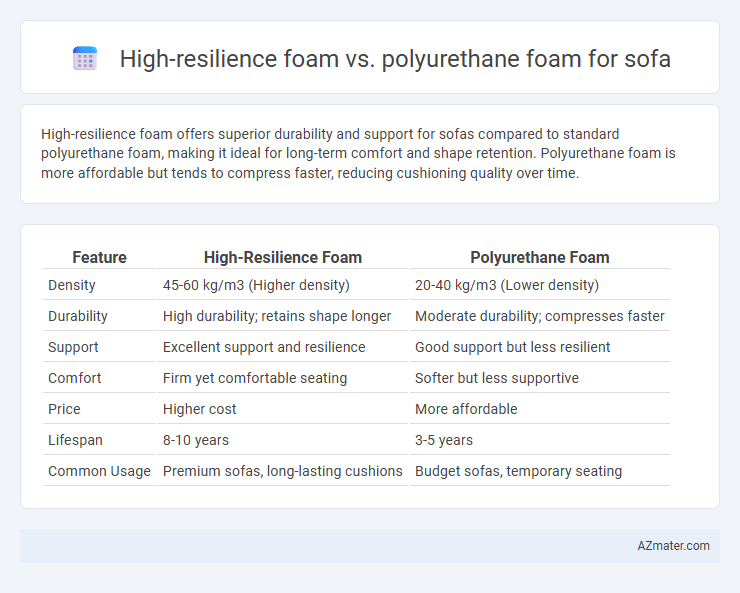High-resilience foam offers superior durability and support for sofas compared to standard polyurethane foam, making it ideal for long-term comfort and shape retention. Polyurethane foam is more affordable but tends to compress faster, reducing cushioning quality over time.
Table of Comparison
| Feature | High-Resilience Foam | Polyurethane Foam |
|---|---|---|
| Density | 45-60 kg/m3 (Higher density) | 20-40 kg/m3 (Lower density) |
| Durability | High durability; retains shape longer | Moderate durability; compresses faster |
| Support | Excellent support and resilience | Good support but less resilient |
| Comfort | Firm yet comfortable seating | Softer but less supportive |
| Price | Higher cost | More affordable |
| Lifespan | 8-10 years | 3-5 years |
| Common Usage | Premium sofas, long-lasting cushions | Budget sofas, temporary seating |
Introduction to Sofa Foam Types
High-resilience foam offers superior durability and support, making it ideal for long-lasting sofa cushions that retain their shape under frequent use. Polyurethane foam is a versatile and cost-effective option, available in various densities, but tends to compress faster and may require more frequent replacement. Choosing the right sofa foam depends on balancing comfort, resilience, and budget considerations to meet specific seating needs.
What Is High-Resilience Foam?
High-resilience foam is a type of polyurethane foam characterized by its superior elasticity, durability, and ability to retain shape under prolonged pressure, making it ideal for sofa cushions. Unlike traditional polyurethane foam, high-resilience foam features a higher density and open-cell structure that provides enhanced support and comfort. This foam's resilience ensures better long-term performance, preventing sagging and improving seating experience in upholstered furniture.
Understanding Polyurethane Foam
Polyurethane foam, widely used in sofa cushions, offers a balance of comfort and affordability with moderate durability and support. High-resilience foam, a subtype of polyurethane foam, provides enhanced elasticity and longer-lasting firmness, making it ideal for sofas requiring superior shape retention and comfort over time. Understanding the differences in cell structure and density between standard polyurethane and high-resilience foam helps consumers select the best material for durability and comfort in upholstery.
Key Differences Between High-Resilience and Polyurethane Foam
High-resilience foam offers superior durability and elasticity compared to regular polyurethane foam, making it ideal for sofas requiring long-lasting comfort and shape retention. Polyurethane foam varies broadly in density and firmness, often resulting in less consistent support and quicker compression over time. The cell structure of high-resilience foam is more open and uniform, enhancing breathability and resilience, whereas standard polyurethane foam typically has a denser, less flexible matrix leading to reduced airflow and softness.
Comfort and Support: Which Foam Performs Better?
High-resilience foam offers superior comfort and support for sofas due to its greater durability and ability to retain shape over time, providing consistent cushioning and pressure distribution. Polyurethane foam, while more affordable, tends to compress faster and lose its supportive qualities, leading to less comfort during prolonged use. Therefore, high-resilience foam is generally the better performing option for maintaining long-term sofa comfort and structural support.
Durability and Longevity Comparison
High-resilience (HR) foam offers superior durability compared to standard polyurethane foam, maintaining its shape and comfort over extended use due to its higher density and advanced cell structure. Polyurethane foam tends to compress and deteriorate faster, leading to sagging and reduced support in sofas over time. Investing in HR foam enhances sofa longevity, ensuring better resilience against daily wear and prolonged pressure.
Price Differences: High-Resilience vs Polyurethane Foam
High-resilience (HR) foam generally commands a higher price than standard polyurethane foam due to its superior durability, density, and comfort retention. While polyurethane foam is more budget-friendly, it tends to compress faster and provides less support over time compared to HR foam. Investing in HR foam enhances sofa longevity and comfort, justifying the initial higher cost for long-term use.
Environmental Impact of Sofa Foams
High-resilience foam typically offers better durability and longer lifespan compared to polyurethane foam, reducing the frequency of replacement and waste generation. Polyurethane foam is often produced using petrochemical processes that contribute to higher carbon emissions, while some high-resilience foams incorporate eco-friendly materials or manufacturing techniques that lower their environmental footprint. Choosing high-resilience foam sofas can minimize landfill waste and greenhouse gas emissions, promoting a more sustainable option in furniture production.
Choosing the Right Foam for Your Sofa
High-resilience foam offers superior durability and support, maintaining its shape and comfort over time, making it ideal for high-traffic sofas. Polyurethane foam, available in various densities, provides affordable cushioning but may compress faster, affecting long-term comfort. Select high-resilience foam for a long-lasting, comfortable sofa that withstands daily use, while polyurethane foam suits budget-conscious buyers seeking short-term comfort.
Final Verdict: High-Resilience or Polyurethane Foam?
High-resilience foam offers superior durability, better support, and maintains its shape longer compared to polyurethane foam, which tends to compress and degrade faster under regular use. Polyurethane foam is more affordable but lacks the loft and resilience needed for long-term comfort and structural integrity in sofas. Choosing high-resilience foam ensures enhanced comfort, longevity, and value, making it the preferred option for quality sofa cushions.

Infographic: High-resilience foam vs Polyurethane foam for Sofa
 azmater.com
azmater.com